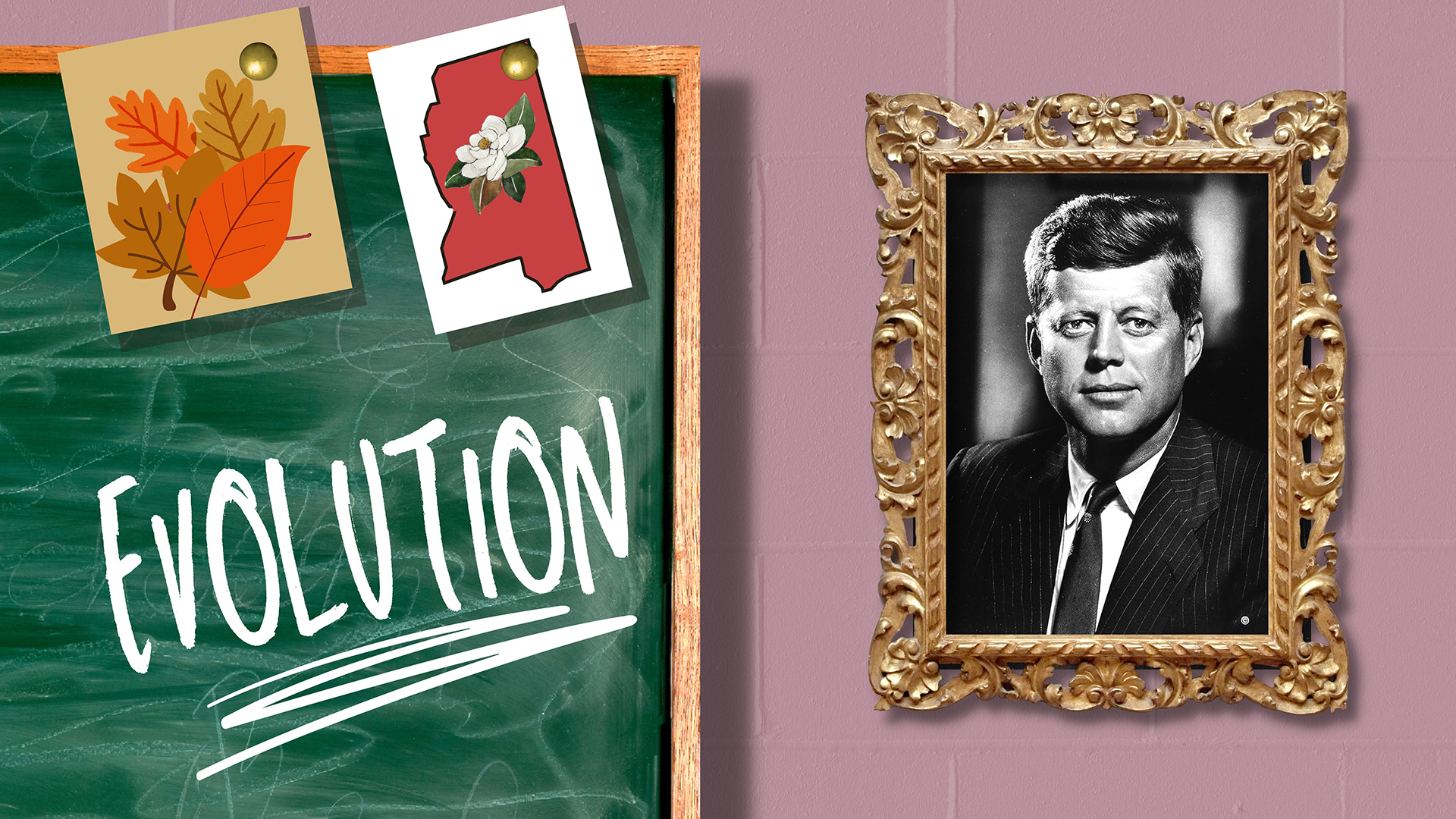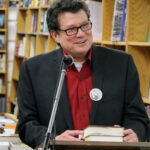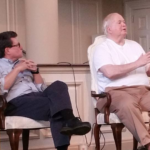
How It Is Down Here
In Mississippi, in 1963, it took an assassin’s bullet to give a young man a peek behind the curtain of the Lost Cause.
As I sat in a seventh-grade science classroom in Mississippi on a warm day in late November, my born-again science teacher said, “One day soon, your faith will be mightily tested by this great abomination.” Then Mrs. Shaw wrote the word EVOLUTION in big block letters on the blackboard.
Like all my teachers, she was a resolute Christian and felt it was her duty to witness in public.
She told us that in college, tests forced her to give answers that blasphemed God, tracing our existence to monkeys, and equating us with “the coloreds.” We agreed that it was terrible to be persecuted for your faith.
She said that to pass the course, she had to put down what she knew were lies. But next to each answer she gave, she cited the Bible verse that disproved it. We thought that shrewd indeed.
Mrs. Shaw thought so as well: “Christ said we are to be clever like a fox.”
I envied Mrs. Shaw her assurance in the face of such adversity. From my perspective, things seemed to be coming apart at the seams.
This was 1963, during the most violent period of the civil rights struggle. The cross burnings, church bombings, marches, riots, and murders were all happening on my Mississippi doorstep. That June, Medgar Evers was murdered only a few miles up the road, shot dead in front of his Jackson home.
Every evening on the national news, there was a story about Mississippi. My elders said we were being invaded. They said people just didn’t understand how it is down here.
Every evening on the national news, there was a story about Mississippi. My elders said we were being invaded. They said people just didn’t understand how it is down here.
This distressed my father, my teachers, my preacher, and all the adults who circumscribed my world, and I doubled down on the story my people were adhering to. I became outraged at how all these outsiders upset those I loved. Why were they picking on us? At thirteen, I was inspired to write a book about my people’s goodness and nobility entitled The Truth About Mississippi. I collected articles on the Lost Cause, the chivalrous South, and the “bright side” of slavery. I wrote stories about the Indians who once populated the state and biographies of our illustrious race-baiting governors like Barnett and Bilbo and patron saints like Jefferson Davis. I included all the Mississippi firsts, biggest, and bests: Borden’s condensed milk was first canned in Liberty, Mississippi. The largest Bible-binding plant in the nation was in Greenwood. The teddy bear got its name when President Theodore Roosevelt went bear hunting in the Mississippi Delta. Mary Ann Mobley, a Mississippian, was named Miss America in 1959.
While Mrs. Shaw reassured us that God had made the heavens and the earth with his own muddy hands, the intercom, that ominous black box that hung from the wall above the blackboard, sputtered. Principal Speight’s crackling voice interrupted Mrs. Shaw’s lecture: “President Kennedy has been shot in Dallas. They are taking him to Park Memorial Hospital.”
The class sat mute.
Into that dead silence, the voice of a child who tore down the hallway past our open door rang out: “They shot the n-----r lover!”
The class burst into spontaneous applause and celebratory whoops and howls. It was as if our team had scored a winning touchdown. Did I clap? Perhaps I did, and then I looked to Mrs. Shaw for a cue.
Her heavily powdered face had gone even whiter than usual, and her mouth dropped. She stared at us in stunned horror, unable to speak.
That brought Mrs. Shaw to her senses.
“Children! He’s our president,” she stammered. “Our president. Of our country. Do you understand?”
She took a breath, and I thought she would say more, but tears rolled soundlessly down her cheeks. We watched her in awkward silence.
At thirteen, I had only the vaguest idea of who President Kennedy was, but I knew he made my parents, teachers, preachers—every adult I respected—unhappy. And they were worried for me. They said President Kennedy wanted to destroy my school by making me attend classes with Black kids. He wanted to ruin my neighborhood by making me live next door to them. He wanted to mongrelize the white race by making me marry a Black girl. And he was willing to go to fanatical lengths to do it: the year before, he had initiated a riot by sending in troops to force Ole Miss to admit James Meredith, a Black man.
Mrs. Shaw’s face betrayed the lies we’d been told. I think we all saw it. We sat silently, casting embarrassed glances at one another, waiting for Mrs. Shaw to tell us how to feel. The play had gone horribly off-script.
That insidious liberal thinking was even invading our living rooms. Just that September, a popular sitcom called The Dick Van Dyke Show aired an episode in which a Black couple shows up at a white couple’s house—at their front door—and are invited in as if they were white people.
Our preacher decried that program the next Sunday. He taught me an unfamiliar word from the pulpit, even worse than integration, communism, or miscegenation. It was sophistication. These coat-and-tie-wearing, cocktail-sipping Yankees who called supper dinner and entertained Negroes in their home were trying to tell us that this mingling was the modern, sophisticated thing to do. Just like the Kennedys were sophisticated. Put that word in a preacher’s mouth, and you can make it hiss like a serpent. Try it—sophissssssstication. They were the spawn of Satan and deserved to die.
So it made perfect sense for us to be happy, even joyous. Not because we felt strongly about Kennedy one way or the other, but because our parents did. Our preachers did. Our teachers did. There wasn’t a day that you didn’t hear grown-ups say, “Somebody ought to shoot that n----r-loving S.O.B.” And nobody, I mean nobody, corrected them.
But now Mrs. Shaw’s face betrayed the lies we’d been told. I think we all saw it.
We sat silently, casting embarrassed glances at one another, waiting for Mrs. Shaw to tell us how to feel. The play had gone horribly off-script. Mrs. Shaw had briefly pulled back a curtain, and we were stricken at what we saw. After an eternity, the intercom sputtered again, and Mr. Speight delivered his second announcement. The president had died. Some of my classmates began to cry. The rest of us stared forlornly out the window. Mrs. Shaw had recovered and was once again in charge. She lectured us on the evils of violence and then pivoted back to the science lesson.
I don’t remember any teacher, preacher, or other adult mentioning the assassination again. We all moved on, and nothing seemed to change. The following year, our town father planned and successfully executed the kidnapping and murder of three civil rights workers.
Yet, for a thirteen-year-old boy, the world had shifted on its axis. Mrs. Shaw, an unlikely hero, inadvertently granted me a glimpse of a truth so irrefutable I began to question the web of lies into which I had been born. In that one brief moment, my understanding of home changed forever.
About the author
Jonathan Odell is the author of three novels, Miss Hazel and the Rosa Parks Club (Maiden Lane Press 2015), The View From Delphi (Macadam Cage 2004), and The Healing (Random House 2012). His essays, short stories, and poetry have appeared in The New York Times, Commonweal, Publishers Weekly, and others. He lives in Minneapolis with his husband.



